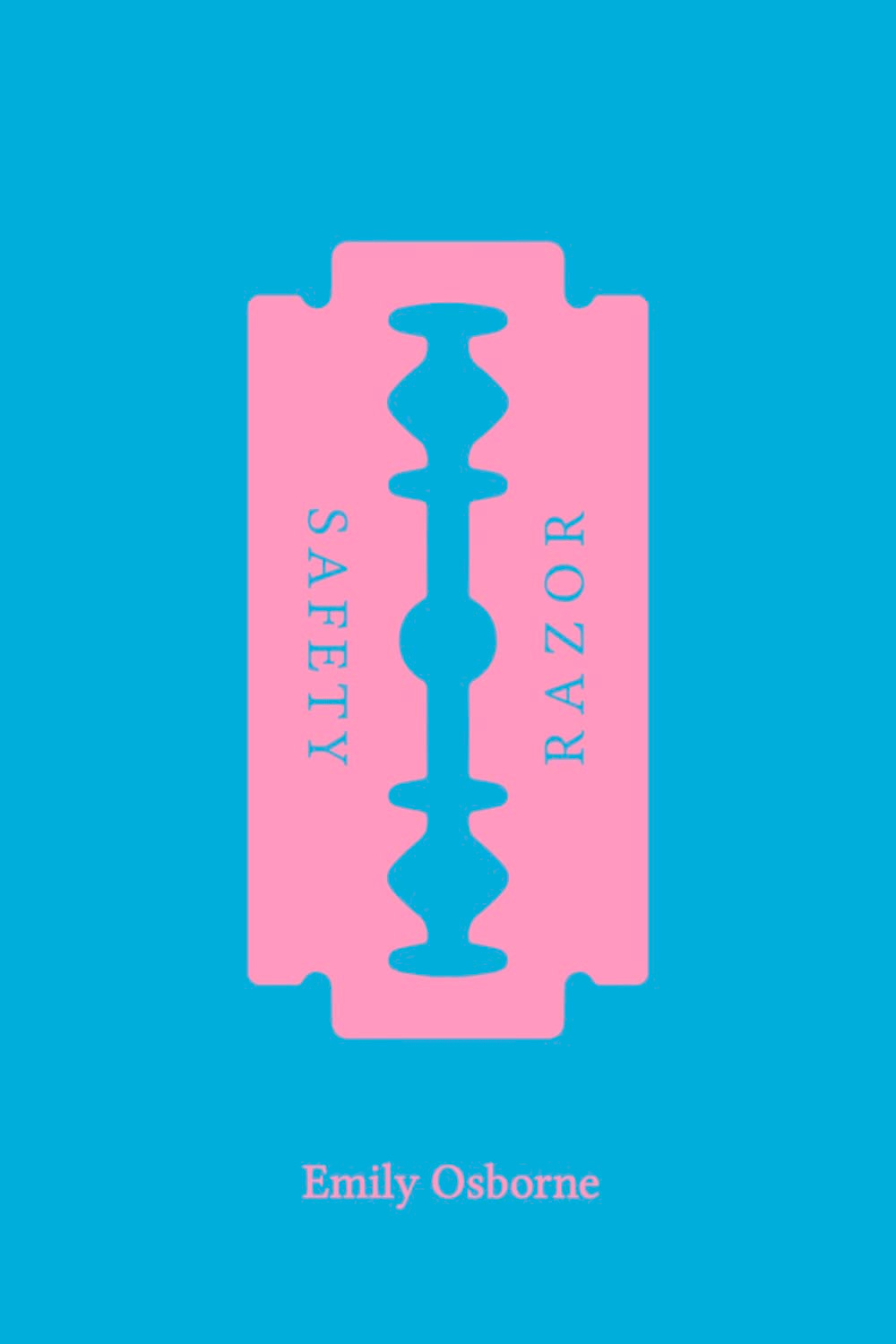Emily Osborne, Safety Razor. Gordon Hill Press, 2023
Review by Maryann Corbett
Best to admit this at the outset: I’m not the ideal reviewer for Emily Osborne’s Safety Razor. I took it on because my curiosity was piqued; the book includes translations from Old Norse/Icelandic and its author is a fellow medievalist. But the kind of poetry I’m most fond of—the music of clear traditional meter, mostly iambic, usually end rhymed—turns out not to be a major part of this collection.
Nevertheless, let me do my mismatched best with the book, which is attractively and intelligently made. Osborne has been well served by her designer: the double-edged-razor-blade silhouette on her cover and division pages hints at the many anxieties and unsettlements in the poems. Does the work say more about life’s dangerous edges than its safety? Or is that an artifact of its use of sound? I hope I can explain.
I’ll begin with the poems that drew me to the task: Like the bright garnets in Anglo-Saxon ornaments, the skaldic verse translations from the sagas are there, small pauses for breath in the book’s three sections. These have three rough themes: family-of-origin stories, meditations on poetry and art-making, and narratives of marriage, early motherhood, and loss. In the first section, “First Cuts,” the translation entitled “Sonatorrek” (“Loss of Sons”) echoes in its accentual meter the family anxieties in that section’s personal lyrics:
Hardly can I hoist
my tongue or mount
song’s steelyard, forge verse
in my mind’s foundry. . . . For the second section, “Bare Bones,” a translation serves as the opening statement—
Goddess of the rune-carved mead mug,
I’ve smoothed the prow of this song-ship.
Lovely lady, tree who carries cups,
I deftly ply my tongue, the lathe of poems. (“Verse-making”)—and it’s clear and satisfying enough, with its runes and mead cup and song-ship kenning and tongue-as-tool, to set out the art-making theme, even if it doesn’t strictly mimic the alliterative patterns, meters, and rhymes of skaldic verse. In the final “Flesh Meets” section, the translations highlight age and death as colors in the pattern of losses. I can’t comment on the faithfulness of these as translations, but as modern English poems, they do their jewel-like work. Scattered two or three in each roughly twenty-page section, they are glints in the design.
But skaldic verse seems to contribute something to the poet’s habits overall: a layer of prickly, crunchy alliteration and assonance, and an unexpectedness of diction that includes a fondness for kennings. Osborne seems to be talking about her own habits when she writes “You said my consonants split and replicate / like cells in tumors” (“Diacritics”). I can’t help thinking that performing these poems aloud for an audience requires more than the usual amount of rehearsal to avoid tangling of the tongue. Even subvocalized, this sound-work is work, and I would argue that it adds tension to the poems even in silent reading.
The opening of “Four drawers” shows how effectively physical, how muscled, such a thicket of sonics and oddities can be:
Objects were entrusted to you, but you were a magician’s box;
in cryptic pockets wadding socks and tops. Refusing to shut
flush, lips jut. In sullen summers, you will not open, rollers
swollen. When clocks fall back and barometers drop, your
knobs will be pumped, varathane shrilling on ruts.Occasionally, though, the mix—so much sonic crunch, so much reaching for unexpected modifiers or unusual verbs, and so much yoking of assorted similes and metaphors—gets in the way of comprehension:
Our bridge home mortars
the broken wrist of water
in air and earth—a prosthetic
gesture. From here, our road
seams like a frayed gravel skein,
and home is a wooden knot
the width of my closed fist. . . . (“Revisiting”)Even if one believes with Wallace Stevens (and I’m not sure I do) that “[t]he poem must resist the intelligence / Almost successfully,” one has to grant that some poems resist the intelligence a bit too well.
The varied examples above only hint at the variety of the book’s many open forms. Among them are a wide range of line lengths, jump cut patterns that scatter over the page, a prose/verse combination, a five-seven-five haiku. And more, with a debut book’s eagerness to show off all sorts of skills. A number of the poems seem to want to be metrical, beginning in accentual trimeter or tet but then meandering off. Many use internal rhyme—another element of their sonic crunch—often pairing an end with a middle. An actual ending heroic couplet, in “Glassblowing,” comes as a surprise.
Amid all this variety, there is just one whole poem in unironic pentameter. Here’s “Relativity of simultaneity”:
The train is punctual in its glossy enamel.
The train auto-corrects, inserting commas
into a run-on sentence. In these caesuras,
doors open in sync to greet commuters.
Or do they? I’m running along the platform,
but the nearest door is always closing sooner.
The train’s line scans in iambic metre, lips
contracting one syllable after another.Anyone who’s ever run for the subway or the light rail train understands this striking extended metaphor. Still, it’s odd that here Osborne associates regularity with unthinking run-ons and auto-correct, odd that what prompts her to use a fairly regular pentameter is the contemplation of things mechanical. It’s as though she hears in traditional meter the clack of gadgets rather than the pulse of music.
Perhaps most readers will care less about sounds than about subjects. Unlike a lot of debut books (especially the contest-oriented kind), this one is not a through-composed story. Rather, it’s a miscellany; it takes in a wide range of topics. In the first section are early memory, games, particular toys (the strange Transformers called “Decepticon”), schoolwork, and a drowning. In the second section’s expansive theme of “making,” subjects are all over the map: poetry, scrimshaw, weather, evolution, geological eras and tectonics, the story of Jumbo the elephant, that train on the platform. The third section opens with love and marriage, spends several poems on pregnancy and birth, wanders on the way through heirlooms and objects, and closes with a burial.
Some subjects, though, are simply more appealing than others, and I confess that the poem that most pleases me in this collection is “In the Uffizi Gallery on our honeymoon.” I don’t think I’m alone in liking it; I suspect it was placed at the start of the third section to take advantage of its wide appeal. It dispenses with heavy layers of sound and device and intricacy of diction, preferring a clear story, happy and plainly told. It uses appealing images and a single controlling metaphor: the narrator, and her great good luck in love, as Botticelli’s Venus. It lacks the metrical music I’d prefer, but it has other strengths. Here are its closing tercets:
Today our mise-en-scene is faultless.
Let me enjoy it. For decades I floated
alone in a little shell, saving it
from splitting with backbone and grit.
You didn’t blow in on an announcement,
never rescued me from swells I couldn’t handle.
But when we met at eye level I knew
I was blessed, stepping off a rough-brushed
ocean, sure of the story, not even wet. Call me simpleminded, but this is a poem that pleases me, especially with its lovely visuals taken from Renaissance art.
Maryann Corbett is the author of six books of poems, most recently The O in the Air from Colosseum Books / Franciscan University Press. Her work has appeared or is forthcoming in Beloit Poetry Journal, Image, Raritan, and many other journals, and in anthologies like Measure for Measure: An Anthology of Poetic Meters and Best American Poetry 2018. She is a past winner of the Richard Wilbur Award and the Willis Barnstone Translation Prize.





